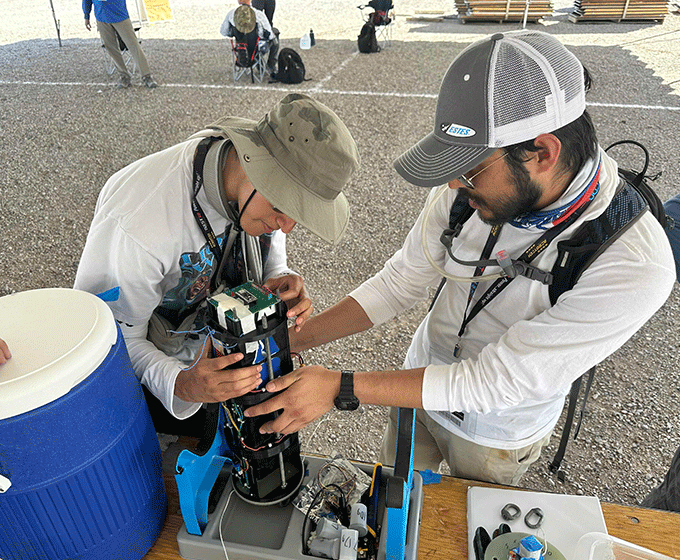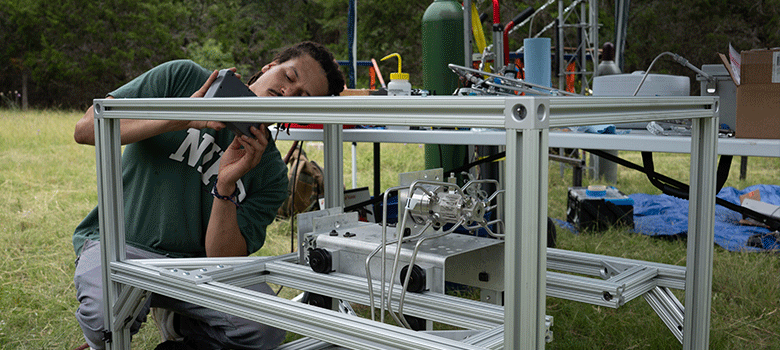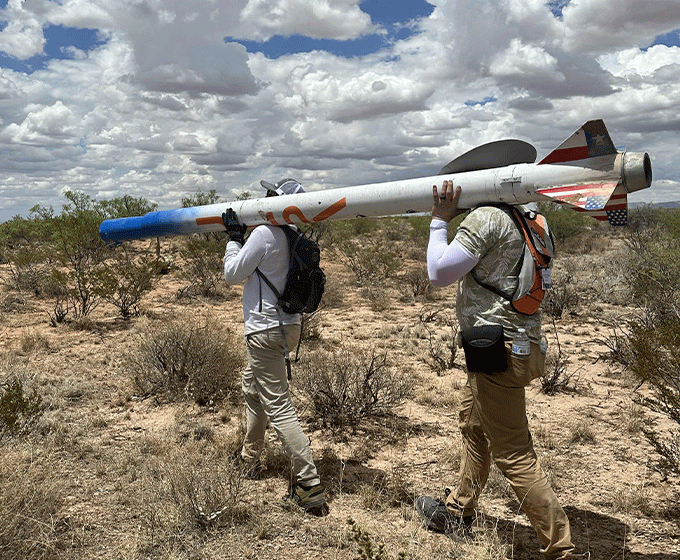
The UTSA Aeronautics and Rocket Club (ARC) offers students the opportunity to work on research-heavy projects, apply their classroom knowledge and compete in competitions, including the 2020 NASA Student Launch competition.
OCTOBER 9, 2024 — On a clear night, Joe Hernandez-McCloskey will sit outside to admire the moon, thinking about the day he’ll be looking back at Earth from the lunar landscape. For now, he has his feet in the UTSA Laser Spectroscopy and Chemical Propulsion Laboratory.
Hernandez-McCloskey is among a UTSA collective with their sights set on space. Guided by leading faculty, this distant world has become a reality for this next generation of explorers.
Hernandez-McCloskey was applying to graduate school when he met Daniel Pineda, UTSA assistant professor of mechanical engineering, in the California desert. Encouraged by Pineda and his research vision for rocket propulsion, Hernandez-McCloskey enrolled in the UTSA mechanical engineering doctoral program in 2020.
Now the two are working on new research together in the lab. They’re advancing rotating detonation rocket engine technology through additive manufacturing and laser absorption spectroscopy.
“When it comes to conventional rocket technology, we’re reaching the maximum efficiency of that process. We’re pretty much reaching the limits of thermodynamics,” Hernandez-McCloskey said. “If we can get the rotating detonation rocket engine technology working, it’s increased efficiency. We can open up the floor to things beyond multimillion-dollar projects. In terms of sending stuff from the Earth’s surface, this is definitely the next step.”
The approach to launching rockets out of the Earth’s atmosphere is new. It’s also what secured Hernandez-McCloskey’s spot as a 2022 NASA Space Technology Graduate Research Opportunity fellow.
The UTSA doctoral student uses non-intrusive methods such as lasers to measure the properties of gases in harsh environments, like high-temperature, high-pressure rocket exhaust. His goal is to evaluate the performance of next-generation rocket technologies.
“We are setting the foundation in San Antonio to get our students trained on rocket propulsion. We’re using UTSA resources, working with the metal 3D printer to make hardware, to show we’re capable of making rocket propulsion research happen here,” he said. “We have a really strong base of students here, and I think we’ve got a lot of future space professionals right here among us.”
UTSA alumnus Jahsiah Toby ’20 ’23 discovered a course on rocket propulsion during his senior year of college. The undergraduate course, developed and led by Pineda, made Toby’s ultimate dream of getting people to the Martian surface attainable.
“It gave me insights into designing rocket engines that I needed,” Toby said. “It helped make it real, because all the concepts within the class were things that were one step beyond what we’d already been learning throughout our entire undergraduate curriculum. I love space in general, but that rocket propulsion class was a very deciding factor.”
Today, the UTSA alumnus is putting to practice what he learned as a student in his role at Relativity Space designing rockets.
Relativity Space focuses on revolutionizing the process of rocketry, from design to flight. The company built and launched the world’s first 3D printed rocket, Terran 1, in March 2023. Currently, Toby and others at Relativity Space are working to bring Terran R, a reusable launch vehicle, to market.
Toby built his knowledge in 3D printing at UTSA. He worked on projects as a student in the UTSA Aerospace Engineering graduate program, where he designed, fabricated and analyzed small-scale, additively manufactured rocket engines.
He developed the engines’ components as a graduate student. His experiments included thermal and propulsive performance analyses and post-fire inspections.
On one occasion, Toby was characterizing an orifice responsible for the propellant flow for engine efficiency. Typically, information about these components is readily available when purchased, but since the group made the parts themselves and were drilling together the orifices, they needed to gather the information on their own through component level testing.

Jahsiah Toby '20 '23 assembles an additively manufactured, 3D-printed rocket engine.
What seemed at the time as a minor step toward a larger project ended up setting Toby apart at Relativity Space.
“Some months later, we actually had a similar problem here where we needed to better understand the characteristics of custom parts made in-house. I was selected to look into it because I already had prior experience,” he said.
The UTSA Department of Physics and Astronomy also offers opportunities to study and conduct research in space science. It offers bachelor’s, master’s and doctoral programs in physics and jointly offers the Space Physics Graduate Program in collaboration with Southwest Research Institute.
Michael Velez, a UTSA graduate student in the joint doctoral program, will complete his degree in May 2025. Before he crosses the Commencement stage, he’ll take the galactic sky as a contributing member to the Europa Clipper Mission. The mission, launching in October 2024, will help scientists on Earth determine the potential habitability of Europa, a moon of Jupiter.
 As members in the UTSA Aeronautics and Rocket Club, students are equipped with competitive skills to launch successful careers.
As members in the UTSA Aeronautics and Rocket Club, students are equipped with competitive skills to launch successful careers.Velez is planning the stellar occultation observations for the Europa-UVS instrument, slated to perform multiple fly-bys of Europa. He built a catalog of ultraviolet bright stars to help guide the instrument. He published his research in The Planetary Science Journal, ushering him further toward his goal of working on future missions.
“I know the Voyager was before my time, but it still was influential because you see those photos and think about all the work that went into it, all the people that had to do it. Now, thinking about that, I’m one of those people,” said Velez. “It’s an opportunity that I never thought I’d be able to have, so I’m very grateful that NASA has the option for graduate students to be affiliated with these missions and that universities and programs like these can then give it to the students.”
UTSA faculty have made significant contributions to space sciences research in recent years. For example, leading up to the 2024 total eclipse, Angela Speck, professor and chair of the UTSA Department of Physics and Astronomy, was a leading expert in providing insight into the event.
In 2023, UTSA astrophysicist Thayne Currie partnered with the Subaru Telescope and the European Space Agency to capture one of the first-ever images of an exoplanet seen by the JWST.
That same year, NASA recognized UTSA faculty Xinting Yu with a Planetary Science Early Career Award, aimed at establishing a Planetary Material Characterization Facility. In 2022, UTSA astronomer Richard Anantua played a pivotal role in the Event Horizon Telescope project, contributing to the first-ever image of black hole Sagittarius A*. UTSA faculty have also partnered on several NASA-funded small business innovation and technology transfer projects.
UTSA students have opportunities to contribute to space research. The largest and most powerful telescope in the world, JWST produces images of deep-space marvels with exquisite details. Mason Leist ’24 led a study as a graduate research assistant on the best method to improve images obtained by JWST. His work, published in the Astronomical Journal, has garnered significant interest from fellow scientists working on JWST image processing.
Lulu Zhang, a UTSA postdoctoral fellow, is the first from the university to be awarded time on the JWST as a principal investigator. He earned 12 hours of observation time on the JWST to study supermassive black holes to better understand the birth and evolution of galaxies.
Most recently, UTSA broadened the sphere of collaborators in its space research enterprise by joining the Universities Space Research Association. As a member of the association, UTSA students and faculty with a penchant for exploring the galactic frontier will have new research and education opportunities.
“I think it’s important to contextualize exactly what is happening with the universe. The Earth is unique,” Velez said. “What we have here is really special and it gets even more special when you learn about other planets. It shows how important our planet is."
UTSA Today is produced by University Communications and Marketing, the official news source of The University of Texas at San Antonio. Send your feedback to news@utsa.edu. Keep up-to-date on UTSA news by visiting UTSA Today. Connect with UTSA online at Facebook, Twitter, Youtube and Instagram.
Move In To COLFA is strongly recommended for new students in COLFA. It gives you the chance to learn about the Student Success Center, campus resources and meet new friends!
Academic Classroom: Lecture Hall (MH 2.01.10,) McKinney Humanities BldgWe invite you to join us for Birds Up! Downtown, an exciting welcome back event designed to connect students with the different departments at the Downtown Campus. Students will have the opportunity to learn about some of the departments on campus, gain access to different resources, and collect some giveaways!
Bill Miller PlazaCome and celebrate this year's homecoming at the Downtown Campus with food, games, giveaways, music, and more. We look forward to seeing your Roadrunner Spirit!
Bill Miller PlazaThe University of Texas at San Antonio is dedicated to the advancement of knowledge through research and discovery, teaching and learning, community engagement and public service. As an institution of access and excellence, UTSA embraces multicultural traditions and serves as a center for intellectual and creative resources as well as a catalyst for socioeconomic development and the commercialization of intellectual property - for Texas, the nation and the world.
To be a premier public research university, providing access to educational excellence and preparing citizen leaders for the global environment.
We encourage an environment of dialogue and discovery, where integrity, excellence, respect, collaboration and innovation are fostered.